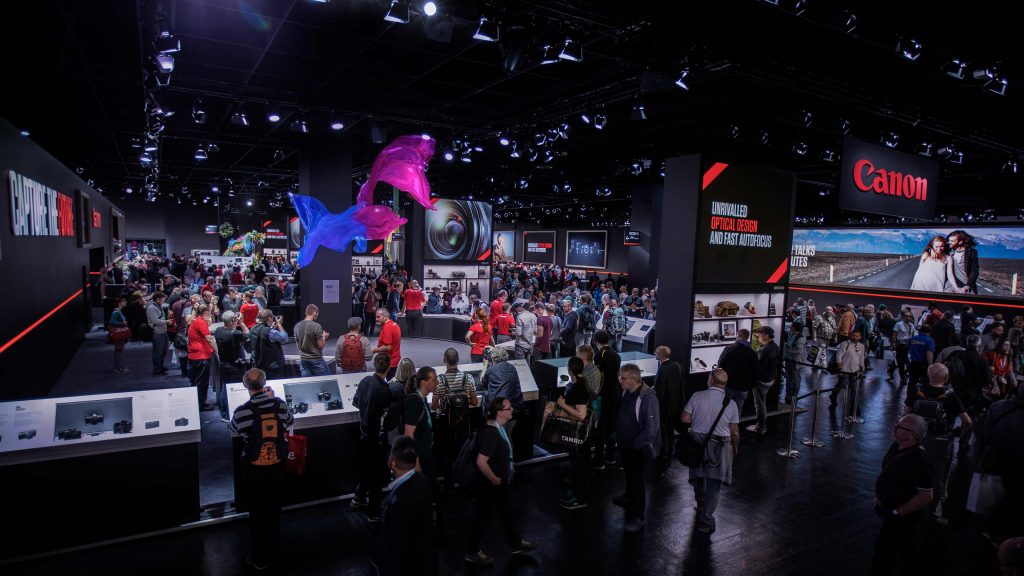World Exhibition Stand Awards.
As we near the end of our 25th anniversary year, this interview recaps some our most important insights: experiential measurement and innovation, what’s driving industry change, why winning a Platinum award was such an honour and much more.
Special thanks to World Exhibition Stand Awards for first publishing this interview with Andy Sexton in December 2019.
What did it mean to you to win in the inaugural World Exhibition Stand Awards?
It’s important that all 2LK’s marketing efforts dovetail into our ‘Effective Experiential’ positioning. This means we’re very selective in terms of the work we take on and the awards we enter, only submitting projects that we’re supremely confident about in terms of being innovative and impactful, with fantastic proof of measurable results. That’s why the World Exhibition Stand Awards appealed to us, and that’s why winning one of a very small number of Diamond Awards from our single entry for Canon at Photokina was such a great result – with many of our clients, peers and competitors also commenting on it.

What has been the best innovation of the past 5 years?
It’s always been hard to measure design’s impact for live activations. They typically last just a few hours or a handful of days, so there’s only one shot at measurement. We can’t refine the tools and techniques post-launch and making real time executional tweaks is tough. There’s usually an absence of financial transactional data and in most cases the live attendee audience is tiny compared to the volume of ‘users’ in other marketing channels.
However, with recent technological advances it’s now possible to transcend typical transactional data and quantitatively measure those things that were previously unmeasurable. Attendee tracking via WIFI polling beacons, RFID/NFC/Bluetooth badge tags, heat mapping and real time video surveillance systems provide immediate and accurate attendee statistics. With visitors ever more comfortable with the idea of exchanging their data for valuable rewards, smarter event apps are also enabling deeper user profiling.
What are clients currently asking for in stand and experience design?
What clients are not asking is more telling. It’s amazing how infrequently clients and prospective clients ask about measuring the effectiveness of their activations. In today’s world of accountability, it’s in their interest to devise benchmarks and objectives at the briefing stage.
For any agency founded on creating effective experiences like 2LK, the brief is an indispensable document, critical to a project’s ultimate success. It’s a shared tool for client and agency, used to filter all decisions and ensure the work meets its objectives. Setting defined and focused goals is essential from the get-go.
What do you expect the next 5 years will hold for exhibition stand design?
For me, personalisation is the one major guiding principle that’s going to drive change across the experiential industry over the next few years. It’s firmly embedded in our digital lives and we’re now expecting it in every facet of our interactions with brands.
Personalisation is powerful – people want to feel like they belong to something, that they matter and that their engagement offers a good value exchange. Marketing is far less annoying when it’s relevant. Attendees aren’t just open to personalisation, they are actually starting to expect it – and because it removes friction from an experience, they’re even beginning to demand it.
What are the biggest challenges for exhibition stand design and build currently?
With longstanding events like Paris Motor Show, Photokina and Baselworld struggling (and CEBIT recently dying altogether), you’d be forgiven for believing the hype that trade shows are on the brink of extinction. But I really don’t think that’s true.
In the broader sense, event attendance is actually increasing. The problem is the failure to observe the shifting expectations of visitors and to recognise the fragility of the participating brands, and then adapt accordingly.
The formula for a successful event (be it trade or consumer focused) is changing. Events with a primary focus on the attendee experience are on the rise. Events that combine a festival mentality with an exhibition to bring together culture, music, art, food, style, sports, innovation, activism and education continue to grow year-on-year.
Think ComplexCON, SXSW, Cannes Lions International Festival of Creativity and Coachella. These events feel celebratory in nature. They promote topical content agendas and encourage creativity/new ways of thinking. Crucially, they evolve quickly – responsive to all the glorious peccadillos that make us human. They tend to elicit a village feel in their execution and build communities around their attendees. They encourage learning and participation, whilst crafting a personalised visitor experience where content consumption can be customised, creativity is celebrated and human connection is encouraged at every junction.
I believe there’s still a strong future for business events, but those that thrive will probably be smaller multi-dimensional networking occasions – social gatherings that curate bespoke audiences and focused sponsorship of cultural happenings.
More reading:
DBA Interview: Building on 25 Years of Success.
Better Briefs: Make Them More Effective.
Effective Experiential: Beware the PR Stunt.
Let’s Get Personal.